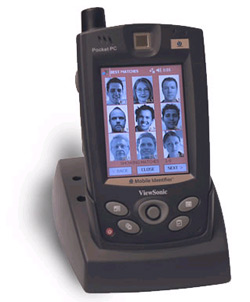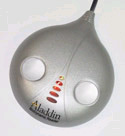Article
From handprints to heartbeats: Acceptance grows for biometrics
No longer the stuff of science fiction, biometric technology is seeing major growth in both innovation and levels of consumer acceptance. New systems move from fingerprints to voice, face and even heartbeat recognition.
April 23, 2006 by James Bickers — Editor, Networld Alliance
Consumers, ever more aware of high-tech crimes and identity theft, are increasingly likely to turn to biometrics as a solution. Businesses want in on the action too, having seen the benefits of a "fool-proof" identity recognition system.
Several surveys recently found that consumers are willing to pay for the added security biometrics can bring to their retail and banking transactions. The Unisys Corp. polled 1,000 Americans late last year in a study of identity fraud and bank security issues. Nearly 40 percent of study respondents said they are willing to pay fees for more protection compared to 27 percent in the year prior. Fifty percent would consider switching banks for more protection, compared to 45 percent a year before.
|
A similar study conducted by Unisys in the United Kingdom revealed that two out of three U.K. consumers would opt for biometric protection to combat fraud. That study also showed that 73 percent would select biometrics to combat identify theft.
AuthenTec, developer of fingerprint sensor technology, sponsored a survey about mobile phone security. Fifty-eight percent of U.S. mobile phone users polled said they would purchase a phone with biometric protection and wireless banking transaction capability. And 47 percent said they would switch services to get these features.
Knowing when to hold `em
Casinos and racetracks, no longer content to let people gamble while they're at the table or the betting window, are exploring ways to make gaming portable - and biometrics are making an impact. Security is key in such instances, as portable gambling devices take the transaction away from the "eyes in the sky" and the scrutiny of the dealer or the teller.
At the end of March, Diamond I Inc. acquired all of the rights to a patent-pending voice-recognition biometric security technology. The company plans to pair the voiceprint technology with its existing fingerprint scanners to provide them with valuable patent claims in the field of biometrically secured wireless casino, pari-mutuel (horse racing) and sports book gaming.
Hyperlinks to the real world One interesting use of Neven-Vision's technology is the company's I-Scout, a "visual mobile search" system. Users snap photos with their camera phones, then send the image to the I-Scout server; the image is recognized and synched up with the relevant digital content, which is then sent back to the user. The company refers to the idea as creating "hyperlinks" to the real world. For example, the company ran a campaign for Coca-Cola in teen magazines in Germany. In exchange for sending in an image of the Coke logo from an advertisement, participants could download a game they could play on their cell phone. Another example could be snapping a picture of a movie advertisement. Once you've sent it in, you can have the choice of watching a trailer, finding show times, putting that film in your NetFlix queue, or reserving the DVD from Amazon when it comes out. |
Their featured product is the hand-held Wi-Fi-based gaming system for on-premise use by casinos and resorts, the WifiCasino GS Concierge and Gaming System, which resembles a PDA and bears a 6.5-inch screen. The GS Concierge allows casino visitors to gamble anywhere in the building - in their room, at the restaurant or poolside.
The company also said it would pursue ways to use voice recognition to create cellular gambling products.
"We believe our 'voice-print' technology will make it easier to implement user-friendly cellular gambling, including the new generation of video-enabled cell phones," said David Loflin, Diamond I's chief executive. "We are most excited about how dynamic the application of our technology can be within the vast international cellular-gambling business."
Take a picture Â… or a pulse
 |
| Neven-Vision's Mobile Identifier can perform facial recognition in the field. The application seen here is used by Los Angeles law enforcement. |
Great technology often solves more problems than the ones it was designed to tackle. That might be the case with Neven-Vision's "Mobile Identifier," which uses facial recognition to provide positive identification. While designed for law enforcement - allowing officers to snap a suspect's photo with a mobile device and request a database search while still in the field - Mobile Identifier has obvious potential for retail payment use (see sidebar).
Neven-Vision is testing prototypes with the LAPD's gang task force. The device carries up to 200,000 records, so it can be utilized in areas where Wi-Fi connections are unreliable.
While most biometric devices look at fingers or eyes, the technology is broadening into other areas where humans are unique. Tel Aviv-based Aladdin Knowledge Systems has unveiled a prototype security system that identifies users based on their heartbeats. The cardio-based technology provides authentication using a person's natural "BioDynamic Signature" (BDS), which is unique to each individual.
 |
| Aladdin Knowledge Systems' BDS reader uses two fingerprints to measure a user's heartbeat, which is turned into a uniquely identifiable profile. |
A person's BDS is determined by touching conductors on a mouse-sized device with a finger from each hand. The reading is based on signals produced by the human body, including a combination of electrical signals from the heart and central nervous system. The sensors measure the signals, run them through an algorithm on a computer and create a digital representation of the signature. This BDS is as unique to an individual as a fingerprint or retinal pattern.
One of the advantages of this system is that it is not adversely affected by physical activity because it utilizes both genetic and physiological elements. A scratch or cut can affect a fingerprint scan, but only a heart attack can affect one's BDS reading, according to Aladdin.









